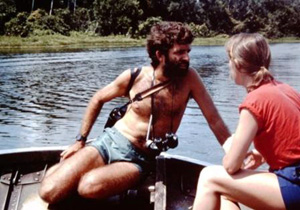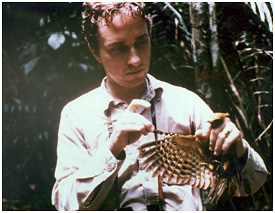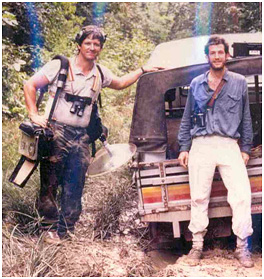History of INPA’s Graduate Program in Ecology

HISTORICAL CONTEXT
During the climax of the Amazon Rubber Boom, from 1879 to 1912, the city of Manaus, strategically located at the confluence of the Negro and Amazon Rivers, was known as the “Paris of the Americas”. It was one of the richest cities in Brazil, the first to be supplied with electricity, and the second to receive piped water, telephones, paved streets and public transport, in the form of electric trams. In 1909, the first Brazilian institution for higher education was founded in Manaus, the Free School for Higher Education of Manaós. However, it lasted for only 17 years, and was deactivated in 1926, with the steep social and economic decline caused by the end of the rubber boom.
Higher education only came back to Manaus in 1962, with the foundation of the University of Amazonas (later Federal University of Amazonas – UFAM), during the presidency of João Goulart. In 1967, the state of Amazonas had an economic revival, with the creation of the Free Trade Zone of Manaus, which attracted manufacturing industries, especially in the electronics sector, and turned Manaus into the economic powerhouse of northern Brazil.
INPA was created in 1952, ten years before the university, during the second presidency of Getúlio Vargas. The in loco establishment of a research institute was part of the government’s strategy to assertain national sovereignity over the huge territory of the Brazilian Amazon, which was they believed was virtually uninhabited, unknown to the more recent European settlers and deeply depressed economically.
INPA was effectively implemented only in 1954, and grew very slowly in the beginning. Compared with the more developed southern and southeastern regions of Brazil, living conditions and research infrastructure in the Amazon were very poor. Rodrigues et al (1985) described the first decades of INPA´s existence in the following sentence: “The precarious condition of the region at the time offered no incentives for the establishment of professionals; therefore the creation of INPA attracted only a few researchers, and most of them returned to their regions of origin soon after.”
In the early years of the 1970s, only two researchers working at INPA held graduate degrees.
A first, but short-lived attempt to promote the qualification of INPA’s research staff followed in 1971-1973, with the creation of an Intensive Training Program in the Amazon (PIATAM), a joint initiative with the Goeldi Museum of Pará (MPEG). The Goeldi Museum was founded in 1866 and is the oldest academic institution in northern Brazil, but suffered badly in the post-rubber boom economic deppression. In the 1970s, the Museum was administratively linked to INPA, under the coordination of the National Council for Scientific and Technological Development (CNPq).
In 1973, INPA moved from its original buildings in downtown Manaus to new and larger facilities in the northeastern outskirts of the city. The road to what is still INPA’s location today had to be paved and the city’s water supply had to be extended to the new campus.
Also in 1973, the first graduate course for masters and doctoral studies in Amazonia was created at INPA. The Graduate Course in Tropical Botany was also one of the first graduate courses in Brazil. The project was conceived and submitted to CNPq for approval by the prominent British botanist, Sir Ghillean Prance, a long-time director of the Kew Royal Botanic Gardens, who was a visiting research fellow at INPA for several periods in the 1960s and 1980s.

Sir Ghillean Prance created INPA’s first graduate course (Tropical Botany) in 1973 (source: New York Botanical Garden and Mercopress).
INPA turned the tide when Warwick Estevam Kerr was named as INPA’s director in 1975, with strong support from the president of CNPq. At that time, Dr. Kerr was already an internationally renowned scientist, who had worked with Theodosius Dobzhansky, and had lectured in several universities in the US and Brazil. He arranged for many of INPA’s research staff to obtain graduate degrees at the best universities in Brazil and abroad, and attracted many young, bright and enthusiastic researchers from Brazil and all over the world to work at INPA.
When Dr. Kerr left Manaus in 1979, INPA had gone from having only two to 110 graduated researchers out of 233 research staff, as well as four inhouse graduation programs.

Warwick Kerr, diretor of INPA from 1975 to 1979, gave a huge impulse to trianing and hiring of research staff (source: ebras.bio.br and abelhasemferrao.com).
INPA’S ECOLOGY GRADUATE PROGRAM – THE BEGINNING
The only researcher with a PhD at INPA in the early 1970s was Herbert Otto R. Schubart, with a bachelor´s degree from the Fedral University of Rio de Janeiro (UFRJ) who had recently obtained his doctoral degree from the University of Kiel (Germany), with a thesis on Amazonian arachnids. He wrote and submitted the proposal for a masters and doctorate program in Ecology to CNPq. As a result of his effort, the Graduate Program in Ecology was created at INPA in 1976, and Dr. Schubart was the Program’s first coordinator.

Herbert Schubart, in 1979, on the margin of the Negro River in Manaus (photo contributed by H. Schubart).
The year 1976 was very important for ecology in Brazil, because the first graduate courses in Ecology were launched at INPA (courses in Ecology and Ichthyology), in São Paulo at the State University of Campinas (UNICAMP) and the Federal University of São Carlos (UFSCAR), and at the Federal University of Brasília (UNB) in the capital of Brazil. INPA’s and UFSCAR’s Ecology courses were the only ones to be approved for both masters and doctoral degrees. The other three courses had their doctorate courses approved betweeen 1980 and 1993. INPA’s Ichthyology course was later renamed as Freshwater Biology and Inland Fisheries, as it is known today.
In its first years, INPA’s Ecology Program profited from the significant contribution of Herbert Schubart and Ilse Walker, who supervised many theses in the 1970s and early 1980s. Ilse, a Swiss biologist specialised in trophic relations in aquatic systems, had previously worked at universities in Switzerland, USA, Tanzania and the UK. She was a faculty member of the Ecology Program until 2006. Dr. Schubart was INPA’s vice-director from 1982 to 1986, and left INPA in 1991 to work as a special advisor for the federal government.

Herbert Schubart (on the right) in 1986, at INPA with Prof. John Kenneth Galbraith, Nobel prize in Economy, and his wife (photo contributed by Herbert Schubart).
Several visiting researchers from other Brazilian institutions and from abroad acted as theses supervisors during the first years of the Ecology Program, including Paulo Emilio Vanzolini, Eneas Salati, Keith Brown, Woodruff Benson, Wolfgang Junk e Augusto Shinya Abe.

Some of the first masters students at INPA’s Ecology Program, depicted among local inhabitants during fieldwork on the upper Rio Jaú (Amazonas) in 1976. The report of this expedition was submitted to the federal agency responsible for forest management (IBDF) and supported the creation of the Jaú National Park in 1980. From left to right: Carlos José Esteves Gondim, Lauro Eduardo Bacca, Mário Dantas, Nélio Roberto dos Reis, Carolina Joana da Silva (wearing glasses), Maria Christina de Mello Amorozo (in uppermost position), and, from top to bottom, Aloísio Rodrigues Ramos, Ronaldo de Almeida and Ricardo Augusto Pessoa Braga. Lucille d’Amorim Antony (second from left) became coordinator of the Ecology Program in the 1990s (photo contributed by Herbert Schubart).
The first masters degree from the Ecology program was obtained by Miguel Petrere Junior, in December 1977. Miguel had an ilustrious career at the State University of São Paulo (UNESP). In 2011, he shared this memory of his time at INPA with the following passage: “Working at INPA at that time, under the leadership of Dr. Kerr and the enthusiasm of the newly created course [in Ecology] was delightful. There was a lot of money for research, everything was new and interesting. Everyday new researchers were hired from different parts of Brazil and the world. I was the second to arrive, having just finished my studies in Mathmatics and Philosophy. I was hired to implement a system for data collection on fishery production arriving at the Adolpho Lisboa Market [in Manaus] that became my masters thesis and later my doctoral thesis in England.”
The first doctoral degree from the Ecology program was obtained by Nélio Roberto dos Reis, in 1981, with a thesis on the ecology of bats in the Manaus region. Nélio had alredy graduated in the masters course at INPA and went on to make his career at the State University of Londrina, in southern Brazil.
Today the longest serving faculty member of the Ecology Program is Philip Fearnside, who has participated in the Program since 1978.

Philip Fearnside, during fieldwork in the 1980s. He has studied environmental impacts in the Brazilian Amazon since 1974, having spent two years travelling on the Trans-Amazonian Highway before joining INPA in 1978. In 2006, he was the second most cited scientist worldwide in the area of global warming (photo contributed by Philip Fearnside).
GROWTH AND CONSOLIDATION
At the end of 1979, a young Australian ecologist, named William Magnusson, arrived at INPA shortly after having obtained his doctoral degree in Sydney, with a thesis on the reproductive ecology of crocodiles. He soon became a specialist in the ecology of Amazonian crocodilians, and went on to broaden his research interests to general ecological relations in species assemblages and the importance of sampling design in biodiversity evaluation. He was already an internationally renowned expert in tropical ecology when he designed the RAPELD sampling system and started the largest program to date for the promotion of integratable sampling designs in the Amazon basin. Bill became a faculty member of the Ecology Program in the early 1980s and has supervised over 50 masters and doctoral thesis.


William Magnusson in Reserva Ducke in the 1987 and in 2003 (credits: Xavier Desmier and Albertina Lima).
Throughout the 1980s and 1990s new researchers kept arriving at INPA and joining the Ecology Program. Several came from abroad, such as Bruce Forsberg, Richard Vogt and Mario Cohn-Haft, or from other regions in Brazil, such as Renato Cintra. Several started their graduate training at INPA and went on to obtain their doctoral degrees abroad, such as Flávio Luizão, Regina Luizão, Tânia Sanaiotti, Elizabeth Franklin, Rita Mesquita and Heraldo Vasconcelos. Others, such as Maria Teresa Fernández Piedade, Albertina Lima and Bruce Nelson obtained their PhD at INPA. The Ecology Program gained a critical mass of highly qualified resident faculty members and diversified its research lines.


Renato Cintra on Río Napo, Ecuador, in 1986 (left) and in his office at INPA in 2006. Renato started his career working in the Pantanal and moved to the Amazon in the 1980s. He participates in the Ecology Program since the 1990s and is among the faculty members who have supervised the greatest number of graduate students. He works on bird ecology and is a keen bird photographer (credits: William Magnusson and Claudia Keller).

Tânia Sanaiotti has undertaken research in the Amazon since the 1980s and participates in the Ecology Program since the 1990s, having supervised many theses. She works mainly on bird ecology and coordinates a program on conservation of the harpy eagle in the Amazon (photo contributed by T. Sanaiotti).

Flávio Luizão coordinated the LBA Program at INPA and was the most important supervisor of theses on ecosystem ecology until his retirement in 2014 (source: LBA archive).

Albertina Lima, depicted during fieldwork near Lago Calado in 1980 (left) and in Ducke Reserve in 2003 is the faculty member of the Ecology program with the second highest number of supervised theses. Her main research interests are the ecology, biogeography and evolution of Amazonian amphibians (credits: Bill Magnusson).
In the 1970s a vivid debate existed in the scientific community about the applicability of the theory of island biogeography to the planning of conservation units, best known by its acronym SLOSS (Single Large or Several Small). The main point was to determine whether biodiversity should be best conserved with one large or several small reserves with equivalent total area.

Thomas Lovejoy, depicted during fieldwork in the 1970s, designed a large-scale experiment to study forest fragmentation in the tropics that became the BDFFP (source: BDFFP archive).
In order to generate field data to contribute to the debate, an ambitious project was started in 1979 in the Brazilian Amazon called the “Minimum Critical Size of Ecosystems”. The project was conceived by Thomas Lovejoy and implemented as a joint initiative of INPA and WWF, creating 23 artificial forest fragments of different sizes within a matrix of pastureland and secondary forests in the cattle ranching district of Manaus. In the 1990s the project was renamed as Biological Dynamics of Forest Fragments Project (BDFFP) and shifted to joint management by INPA and the Smithsonian Institution.

Experimentally isolated forest fragments of the Biological Dynamics of Forest Fragments Project – BDFFP in the agricultural district of Manaus in 1984. (credits: Richard Bierregaard/BDFFP archive)
BDFFP became a worldwide reference for the study of forest fragmentation in the tropics, and supported training and research of hundreds of graduate and undergraduate students from Brazil and abroad. Many faculty members of the Ecology Program started their career at INPA in connection with BDFFP, among them including Heraldo Vasconcelos, Rita Mesquita and Eduardo Venticinque. BDFFP researchers, such as Judy Rankin, Claude Gascon, William Laurence and Philip Stoufer, supervised many theses at the Ecology program in the 1980s and 1990s.

Two pioneer ornithologists of BDFFP in the field in the 1980s. Robert Bierregaard (left) was the first coordinator of BDFFP, and Mario Cohn-Haft has worked in the Amazon since 1987 and has been a faculty member of the Ecology Program since the 2000s (source: BDFFP archive).
Another field site that has a historic relation with the Ecology Program is Ducke Reserve, a 10,000-ha primary-forest reserve owned by INPA, located 25km from Manaus. The proximity to Manaus reduces costs and facilitates logistics of access to sampling sites, but also makes Ducke vulnerable to the impact of the urban expansion of Manaus. At present, Ducke has been turned practically into a forest fragment, isolated from nearby areas of continuous forest by the encroachment of Manaus’ residential districts and by a high-voltage transmission line that passes along the eastern border of the reserve.

The isolation of Ducke Reserve (seen on the images as a dark green square on the northeastern limit of the city of Manaus, in pink) in 1985 (left) and in 2002 (right). Note the expansion of urban areas around the reserve limits. In 2013, the Tucuruí transmission line increased the isolation of the eastern border of the reserve, where the last connection remained to the continuous forest on the eastern margin of the Puraquequara River (source: INPA/SigLab).
The largest part of INPA’s research in terra firme forest in the central Amazon in the 1980s, 1990s and 2000s has been carried out at the BDFFP reserves and Ducke Reserve. Both sites have been listed, respectively, as the first and fourth most well known and productive research sites within the Amazonian and Andean biomes (Pitman et al. 2011).
THE ECOLOGY PROGRAM TODAY
In addition to the veterans from the 1980s and 1990s, new faculty members have joined the Ecology Program since 2000, contributing new disciplines and research approaches to the Program. Eduardo Venticinque, Flávia Costa, Gonçalo Ferraz and Marina Anciães stand out as having supervised many theses in the last two decades.


Bruce Nelson, Flávia Costa and Eduardo Venticinque are among the faculty members that contributed important research lines to the Ecology Program and supervised many theses from 2000 onwards (photos contributed by B. Nelson, F. Costa, E. Venticinque)
Since 2004, INPA’s Ecology Program has been among the 25% best graduate programs in Ecology in Brazil. It was the first gaduate program in the Western Amazon to be awarded qualification level 6 by the Capes Foundation, the governmental entity that evaluates and certifies graduate education in Brazil. Level 6 is the second highest possible and indicates scientific quality and productivity of international standard.
The decade of 2010 marks a transition period in the Ecology Program, with several veteran faculty members from the pioneering years in the 1970s and 1980s approaching retirement. A new generation of researchers prepares to take the helm as faculty members, including several who obtained their doctoral degree from the Ecology Program, such as Fabricio Baccaro, Igor Kaefer, José Luis Camargo and Juliana Schietti de Almeida. Over time, INPA has turned into an attractive workplace for highly qualified tropical ecologists, and several researchers have joined INPA as visiting researchers or permanent staff, such as the new faculty members Camila Ribas, Carlos Alberto Quesada, Fernanda Werneck, Florian Wittmann, Glenn Shepard and Jochen Schoengart.
The steady incorporation of new faculty members and the consistently high evaluation grades obtained over the last two decades show that the Ecology Program has long since overcome the limitations of geographic isolation imposed by its location in the heart of the Amazon.
INFORMATION SOURCES
Magnusson, WE. 2015. The Eye of the Crocodile. Open Science, New York. 459 pp.
Magnusson, WE. 2016. The Fish and the Frogs. Open Science, New York. 372 pp.
Pitman, NCA; Widmer, J; Jenkins, CN; Stocks, G; Seales, L; Paniagua, F e Bruna, EM. 2011. Volume and geographical distribution of ecological research in the Andes and the Amazon 1995-2008. Tropical Conservation Science 4:64-81.
Rodrigues, WA; da Silva, MF; da Silva, AGF e Ribeiro, MNG. 1985. Criação e evolução histórica do INPA (1954-1981). Acta Amazonica (supl) 11(1):7-23
Val, V.M.F.A.; Lira, J.S. e Silva, E.B. 2003. Memória de 30 anos de Pós-Graduação no INPA (1973-2003). Material suplementar (não publicado) de Val, V.M.F.A. (org). 2003. 30 anos de Pós-Graduação na Amazônia (1973-2003) – Catálogo de dissertações e teses do Programa de Pós-Graduação em Biologia Tropical e Recursos Naturais. INPA/UFAM/Petrobrás.
Wikipedia <pt.wikipedia.org/wiki/Ciclo_da_borracha>
Wikipedia <pt.wikipedia.org/wiki/Warwick_Estevam_Kerr>
Wikipedia <pt.wikipedia.org/wiki/Zona_Franca_de_Manaus>
INPA <www.inpa.gov.br/sobre/historico2.php>
UFAM <portal.ufam.edu.br/índex.php/historia#historia>
FAPEAM <www.fapeam.am.gov.br>
Centro de Memória do CNPq <centrodememoria.cnpq.br/cmemoria-index.html>
Personal contributions by Herbert Schubart, Miguel Petrere Junior, Lucille Antony, Bill Magnusson, Philip Fearnside.












